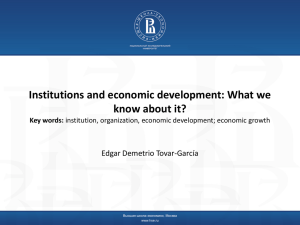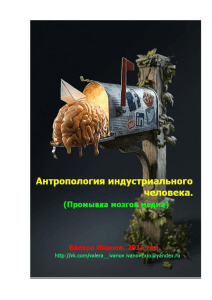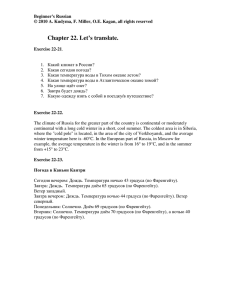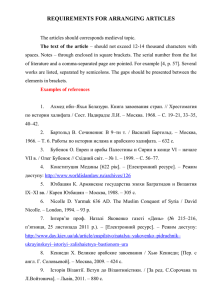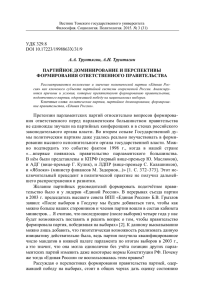OECD EDU – September 18, 2012 RUSSIA STRATEGY 2020: Yaroslav Kuzminov
реклама
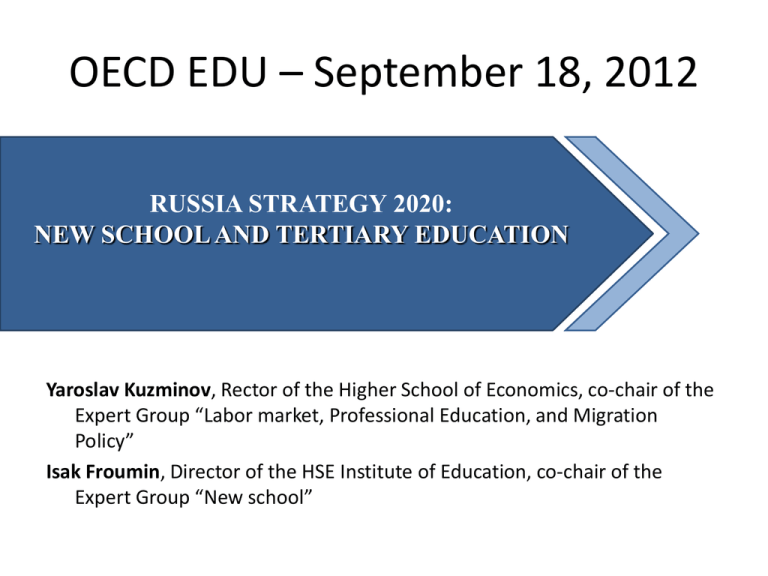
OECD EDU – September 18, 2012 RUSSIA STRATEGY 2020: NEW SCHOOL AND TERTIARY EDUCATION Yaroslav Kuzminov, Rector of the Higher School of Economics, co-chair of the Expert Group “Labor market, Professional Education, and Migration Policy” Isak Froumin, Director of the HSE Institute of Education, co-chair of the Expert Group “New school” STRATEGY 2020: EDUCATION AND SOCIALIZATION FOR CHILDREN There is no catastrophe in education • one of the biggest coverage of general education in the world; • leading positions in quality of education in primary school; • good positions in quality of education in areas of mathematics and natural sciences; • high level of teachers’ formal education; • increasing quality of infrastructure; • commitment and persistence of educated parents; Alarming signs of problems in education • high rate of pupils, who do not achieve satisfactory level of functional literacy; • considerable gap between the least successful and the most successful groups of learners; • growing gap in quality of education throughout different schools and regions; • insufficient development of social competence and positive social attitude among school graduates; • constantly low PISA results (ability to apply received knowledge and skills); • decline of motivation to study among pupils Problems: Outdated quality of Russian education Percentage of students who have not achieved the second level of PISA reading literacy OECD ОЭСР 34.3% Percentage of students who have scored highest in three competence fields Россия Russia 34.3% Лидеры Leaders 27.0% 27.0% 22.0% 20.1% 18.0% 19.0% 2003 2006 4.1% ОЭСР OECD Russia Россия 2000 14.0% 1.4% 2009 One fifth of Russian students constantly score below the threshold level of reading literacy Percentage of “advanced” pupils is lower than the OECD average and much lower than in leading countries Problems: Educational inequality – “weak schools” Resource limitations and educational technologies Groups of students “weak schools” "Слабые" школы Children Дети изfrom неполных incomplete families семей Дети безработных Children of родителей unemployed parents Дети сwhose неродным Children русским языком native language is not Russian 30% 12% 5% Personnel Кадры 18% 13% 5% 9% 2% Организация Organization of обучения education Дети из многодетных Children from large familiesсемей “weak schools” "Слабые" школы Other schools Другие школы other schools Другие школы Percentage of с Доля учителей teachersкатегорией with the высшей highest category Schools,Школы, where there обеспеченные are special (correctional) коррекционными teachers педагогами Percentage of pupils, Доля школьников, studying within the обучающихся по framework of профильным specialized programs программам 34% 55% 6% 36% 19% 71% PISA. Reading literacy. Uneducated children. Level – below 1. 13.6 13 9 8 6 2000 Россия ОЭСР Russia OECD 2003 Linear (Россия) Linear (Russia) 7.4 2006 Linear (ОЭСР) Linear (OECD) Problems: educational inequality – selective schools Quantity of selective schools in Russia, by year Gymnasiums Lyceums Quantity of countries The position of Russia (considering measurement errors) Average score in Russia Comparison of PISA member states Quantity of countries where the results are higher than the Russian ones Quantity of countries where the results are comparable with the ones in Russia PISA results of Russian students, by year Problems: migrants’ children Migrants’ children who moved to Russia after the age of 7 show considerably lower academic progress than their coevals Number of schools Poll’s results in six municipal districts in Moscow region and Saint Petersburg: Ethnic majority Ethnic minority % migrants at school born in St. Petersburg Март 2012 г. came before the age of 7 came after the age of 7 Problems: Access to pre-school education 80% 70% 63% 64% 66% 66% 66% 67% 67% 68% 62% 67% 56% 57% 57% 58% 59% 59% 52% 55% 60% 54% 37% 37% 39% 41% 33% 36% 41% 35% 40% 34% Educational institutions for children aged 5-7 get most attention and financial support. фото Preschool education coverage for children of ages 1 till 3 is only 32.5%. 60% 50% 40% 30% 20% 10% 0% 2000 2001 2002 2003 2004 2005 2006 2007 2008 2009 Всего Total Город urban aria Село фото rural area 80 78.2 70 Preschool education coverage for children aged 1-6 is steadily growing, but is still lower than in 1991, when it was 63%. 71.8 60 50 40 30 32.5 фото 20 10 0 от 1 до 3 Высшая школа экономики, Москва, 2011 от 3 до 5 старше 5 Causes of aggravating problems: General Management Limited offer of services for Limited management capacity on preschool education regional, municipal and school Degradation of teaching staff levels Network of educational Institutional reforms are not establishments does not correspond complete (quality assurance system to changing patterns of settlement is not established) Scale and quality of extracurricular activities is declining Outdated educational content and methods Causes: teaching staff Salary correlation for teachers and other workers USA США UK Великобритания Russia Россия 140% 120% 100% 85% 80% 60% 57% 40% 20% 0% 1960 1970 1980 41.3% 1990 2000 39.5% Teaching staff is aging: percentage of teachers with less than 10 years of work experience is constantly declining. 19.1% early 1990s late 1990s late 2000s Начало 1990-х Конец 1990-х Конец 2000-х 2009-10* Causes: Outdated educational content Number of school subjects (7th grade) 16 14 The structure of basic curriculum 12 10 8 6 4 2 0 USA США France Франция Japan Япония Финлянд Finland ия Russia Россия Количество Quantity изучаемых of school subjects предметов (minimum (минимум) 7 8 9 9 12 Количество Quantity изучаемых of school subjects предметов (maximum (максимум) 9 9 10 10 15 Causes: Declining extracurricular activities Percentage of pupils not involved in extracurricular activities (types of activities) Large cities rural areas sport never arts never Percentage of pupils not involved in extracurricular activities (age groups) medium and small towns Foreign languages never scientific hobby groups Large cities medium and small towns rural areas were not involved in extracurricular activities in elementary school in secondary and high school have never been involved in extracurricular activities never Percentage of children aged 5-18 involved in supplementary education is 49.1%. On average, only 52% of families in Russia have never paid for supplementary education. Purposes of the new development stage in education should be formulated as follows: • Ensuring positive socialization and educational successfulness for each child; • Children have to acquire modern skills. • Thus it is necessary • to stop negative trends; • to modernize the sphere of education in accordance with challenges of changing cultural, social and technical environment. The object of educational policy should be perceived not simply as the system of schools and preschool educational establishments, but as the complex sphere of education and socialization for the young generation. New development resources: • Interest and energy of families. • Creativity of some schools and innovative networks. • Potential of higher education for high school students. • Out-of-school forms: supplementary education, “industries for children”, internet. • Timing (overall educational time in Russia is 25% lower than in OECD). 17 Major areas for changes: • • • • Access to preschool education. Ensuring equal opportunities for all students. Renewal of teaching staff. New quality of content and methods of teaching (breakthrough in spheres of potential leadership and catching up with the backlogs). • Out-of-school education and socialization. • New network of schools • Data collection and evidence-based management Raising access to preschool education: • Federal support to building nursery schools in regions with significant deficit of preschool institutions (deficit of places not less than 10%, where the coverage of children is lower than 70%). • Stimulating the sector of non-government flexible services for young kids through the system of tax remissions and deductions. • Elaborating mechanisms for establishing separate groups of preschool education as independent organizations in specially suited premises; creating external centralized system of management and outsourcing services for childcare. Ensuring success of each child • Creating revealing and record keeping systems for special groups of children in sphere of education (children in difficult situations, migrants’ children, children with disabilities, gifted and talented children). • Support to educational institutions working with the most difficult groups of students and implementation of programs of integration of social and educational integration. • Support to inclusive educational programs for children with disabilities and gifted children in an educational institution and municipal network; preserving and developing special educational organizations. • Support to educational programs of sociocultural integration for migrants’ children (including learning Russian). Renewing teaching staff and teachers’ skills • Raising salaries for teachers in exchange to new contractual duties (effective contract). • Modernization of professional development system. • Modernization of pension system for teachers. • Incentives for young teachers. • Qualification exam for graduates of pedagogical universities and specialists without pedagogical education willing to work in an educational organization. Modernization of pedagogical education • Introducing minimal Unified State Exam score limitations to enter a university with major in pedagogics. • Federal support and delegating a part of functions of professional retraining to nongovernment and non-specialized institutions of higher education, employing new programs, models of training, and utilizing modern educational technologies, forms, etc. • Introducing compulsory year-long internship in the graduate school, based on results of which educational license should be issued. Modernization of content and methods of teaching • New flexible mechanism for renewing the content of education. • Development of educational content and methods in the following areas: “Technology”, “Social sciences” and “Foreign languages”, aimed at achieving new level of learning achievements. • Support to projects of forming new technological environment in the system of education (“digital school”, web 3.0, digital hypertext textbooks), including providing schools with high-speed wireless network access. • Moving Russian mathematical education into leading positions in the world. Developing the sphere of out-of-school education and socialization: • Implementing the mechanism of competition-based financing for programs of supplementary education, summer leisure, and improvement of children’s and young people’s health. • Support to development of municipal social infrastructure and cultural environment for children and young people (exploratoriums, outdoor play sets, playgrounds, social networks, etc.). • Support to integrated media-social projects (TV; Internet; play, documentary, and animated films) aimed at formation of social competences and targets; gaining experience of positive social attitudes and civic values. Modernization stages: • 2012-2015 Centralized promotion of basic standards and new regulatory framework, their implementation (including “new contact”). Support to leading regions’ pilot projects of implementing federal policies through catalytic subsidies. Launching Federal projects of open education and socialization. • 2016-2020 Educational policy decentralization, support to regional initiatives. Development of non-government sector of socialization and education. STRATEGY 2020: TERTIARY EDUCATION Key Labor Market Challenges in 2020 • Up to 25% of the able-bodied population cannot “find their place on the market” due to the gap between their ambitions, competences and the job offers available • Creative workforce and highly-qualified employees are flowing out of the country (the new generation of workers are more mobile and have modern language skills) • The migrant workers coming from the Far East and Asian republics tend to seek permanent residence at a new place rather than work temporarily (just like in the European countries during the 80s and 90s) Structural maneuvering and internal economizing are plausible in the field of education Russian demographic data: historical data and the forecasts 3000 фото 2603 2575 2554 2559 2470 2484 2399 2295 2324 2223 2073 Number of people, thousand 2500 2000 1500 2071 1839 1719 1712 1738174217421729 1686 1726 1703 1675 16381670 1700 1625 1839 149414741521 1494 1676 15991598 1557 1462 1455 1467144514901465 139914551450 1410 1405 1379 1308 12981276132612961347 1278 130812801333 1286 1257 фото 2012год 2010 2020 2020год 1000 Growth in the number of children of school age: by 22% 500 Decrease in the number of people aged 17-20: almost by 30% 0 1 2 3 4 5 6 7 8 9 10 11 12 13 14 15 16 17 18 19 20 21 22 23 24 25 26 27 28 29 30 Age Высшая школа экономики, Москва, 2011 фото фото 28 University Enrollees and Graduates Structured Flows in 2009 (mln. of people) 0.04 1.07 0.29 0.24 Pre-school age children Grade 1 to 4 Grades 5 to 9 0.34 Not catered to by the daycare centers 0.02 Prim.educ 0.76 0.08 Grades 10,11, (12) (Complete sec. school education) 1.29 0.95 0.03 0.01 0.21 ation 0.54 0.02 3 фото0.22 Sec.educa tion 0.63 0.63 0.49 High er educ ation 1.41 0.14 0.42 0.17 1.37 0.64 фот Labor market, military service, other countries Further education opportunities for adults фото 29 Funds Allocated for Financing Secondary and Higher Education in Russia and Other Countries of the World (Per Capita Expenses) 30000 Sec.&Higher Education in Россия - третичное, 2009 Sec.&Higher Education2020 in Россия - третичное, Russia, 2009 Education Russia, 2020 25000 20000 15000 10000 Brazil Mexico Czech Republic Poland Germany France Finland Australia Spain The Neather. Japan UK Sweden 0 South Korea 5000 USA US Dollar (Purchsing Power Parity) 2007 Третичное, Sec.&Higher2007 Structural Changes in Learner Cohorts (During the Last 2 Decades) 66% 37.9% Higher education Higher education (tuition fee paid by parents/student) высшее - по 37.2% Sudden growth in the number фото of university students in 20002010* договорам Higher education (tuition fee covered высшее - за счет by the public funds) бюджетных средств Secondary education (tuition 32.7% Secondary education 28.5% среднее fee paid -byпо договорам parents/student) 7.1% Secondary среднее - за счет education (tuition бюджетных fee covered by средств the public funds) 15.7% 29.4% Primary education 31% 25% 23% 25% 15% 9% начальное Primary education 11.4% 1950 1960 1970 1980 1990 2000 2010 фото 1989 Высшая школа экономики, Москва, 2011 2008 *Sample data provided by the Federal State Statistics Service 31 Educational Program Participants Student cohort structure in the US publicly-funded HEIs in 2009 2-year 2-летние programs Student cohort structure in Russia Primary НПО 4-year programs 4-летние education фото Higher Secondary СПО ВПО education Applied skills and competences obtained education 37.9% 65.7% фот 32.7% 47.5% 52.5% 22.6% 29.4% 34.4% 11.8% 2008 Высшая школа экономики, Москва, 2011 62.1% фото 1989 32 Psychological Aspect in Obtaining a University Degree How important is it for you today to obtain a university degree? Undoubtedly безусловно important 68% 63% важно Somewhat скорее важно important If the post-secondary school graduates could have got a better salary than or the same salary as the HEI graduates, what фото degree would you have recommended your child to obtain, that of a HEI or that 22% 25% 2010 15% 5% 7% Somewhat скорее не важно unimportant 2007 A post-secondary колледж фотВschool degree 2009 безусловно Undoubtedly notне important важно затрудняюсь There is no exact answer ответить 2% 3% 3% 2% Высшая школа экономики, Москва, 2011 23% HEI degree В Aвуз 62% There is no exact answer Затрудняюсь ответить фото 33 The Value of Higher Education and the University Graduates’ Qualifications The share of employers who think the educational establishments’ graduates need further training (as at 2006) Young people who obtained a degree from a HEI 89.5% 68.4% фото 50.1% Needed further on-the-job Почти сразу начинали training полноценно работать 2000 2005 2010 (оценка) Number of educational establishments’ graduates at the labor market, mln. of people Школа School НПО Primary education 2.5 СПО Secondary education ВПО 31.8% Higher education mln. Of people 2 1.5 1 0.5 0 0.68 0.43 0.61 1.11 68.2% 1.2 0.42 0.59 0.19 2001 2005 Высшая школа экономики, Москва, 2011 26.5% фот 73.5% 1.37 0.46 0.24 Became full-fledged employees Нуждались в дополнительном right at the start обучении на рабочем месте 1.15 0.49 0.23 0.23 0.19 0.14 2009 2015 2021 Исполнители Highly-qualified junior высшей rank-and-file employees квалификации Salaried men, office Служащие, фото personnel офисные работники Up to 25% of the First-Year Students Do Not Possess Even the Basic Competences for Continuing Their Education Successfully Number of HEIs requiring the number of USE points Кол-во вузов с соответствующими баллами по ЕГЭ than 40 <40 Less баллов points 40 to 75 points 40-75 баллов 600 500 More than 75 points >75 баллов Enrollees’ minimal USE points (incl. only the фото whose competing students tuition fee is covered by the public funds) 400 фот 300 200 100 фото 0 15 20 Высшая школа экономики, Москва, 2011 25 30 35 40 45 50 55 60 65 70 75 ЕГЭrequirements Minimal UnifiedМинимальные State Examinationsбаллы (USE) point 80 85 90 95 35 Graduates entering the labor market, including the introduction of applied baccalaureate degree programs, millions of people Higher education Applied baccalaureate degree programmes фото Secondary-level vocational education Vocational training programmes (primary-level vocational education) School фот In 2021, the share of applied bachelordegree programme graduates is expected to amount to 28.4% of the фото market. employment Высшая школа экономики, Москва, 2011 36 Performance-based contracting for teachers Secondary vocational education Actual average level of wages Higher education According to HSE “Monitoring of education markets and organizations (MEMO)”: December 2010 Level of wages needed to attract a target profile teacher (“dream teacher”) Level of wages needed to attract young promising teachers Level of wages required to ensure that teachers can stay focused on their main professional activity in thousands of rubbles 37 Inertia scenario issues Low level of wages and unsatisfactory quality of the teaching faculty body Low prestige of the primary- and secondary-level vocational education Education programmes lag behind their international counterparts; “provincialism” Poor level of the student body education profile, low motivation to study Low quality of fee-based education programmes = higher education “underprivileged trap” Insufficient transparency of the higher education system for customers and for the government Low level of adults involvement in further education programmes 38 Key measures: tertiary education Additional financial support required No additional financial support required from the budget APPLIED BACCALAUREATE DEGREE PROGRAMS PERFORMANCE-BASED CONTRACTING FOR TEACHERS SHORT-TERM PROGRAMMES TO DEVELOP QUALIFIED SKILLS IN APPLIED AREAS SUPPORT AND DEVELOPMENT OF INTERNATIONAL AND NATIONALLEVEL RESEARCH INSTITUTIONS INTRODUCTION OF THE MINIMUM EDUCATION REQUIREMENTS FOR THOSE ENTERING STATE-SUBSIDIZED PROGRAMMES NATIONAL OPEN UNIVERSITIES VOLUNTARY PROFESSIONAL CERTIFYING EXAMINATION INDEPENDENT STATE CERTIFYING EXAMINATION «MONEY FOLLOWS THE STUDENT» APPROACH STUDENT LOANS FOR EDUCATION MAINTENANCE ALLOWANCES FOR UNDERPRIVILEGED STUDENTS AND STUDENTS LIVING AWAY FROM HOME, TO THE AMOUNT OF THE MINIMUM MONTHLY WAGE THE COST SET FOR FEE-BASED EDUCATION PROGRAMMES CANNOT BE LOWER THAN THE REGULATORY STANDARDS FOR PROGRAMMES FUNDED FROM THE STATE/PUBLIC BUDGET(S) ENSURE TRANSPARENCY OF EDUCATION INSTITUTIONS AND PROGRAMMES MONITORING OF ALUMNI CAREER DEVELOPMENT AND INCOME MODERNIZATIONS OF THE EDUCATIONAL INSTITUTIONS NETWORK IN THE REGIONS Bridging the labor market and tertiary education To develop regulatory documents to enable implementation of education programmes for adult students by for-profit organisations to provide officially-certified advanced/further professional training; also, to enact regulations that enable these organisations to compete with educational institutions for public contracts. To develop mass entrepreneurial education/training programmes for small- and medium-sized businesses (including voucher co-funded educational and training courses for new entrepreneurs in high-priority industries, such as telecommunications, biotechnology, power production etc.) To establish an educational/training centres network in the countries supplying the labour force to Russia (NIS countries), to ensure their integration into the Russian vocational education system in order to improve the skills and qualifications of migrant workers. To establish a voucher co-funded professional education and training system for disadvantaged populations, including the unemployed, retired, and ethnic minorities (including, alongside with migrant workers, indigenous populations of the Russian North and Far East). To allocate state subsidies to provide retraining for the unemployed youth (representatives of the “excessive higher education” generation) To enable foreign educational providers to have a limited regulated access to the adult education system in technological fields where Russia notably lags behind. 40
